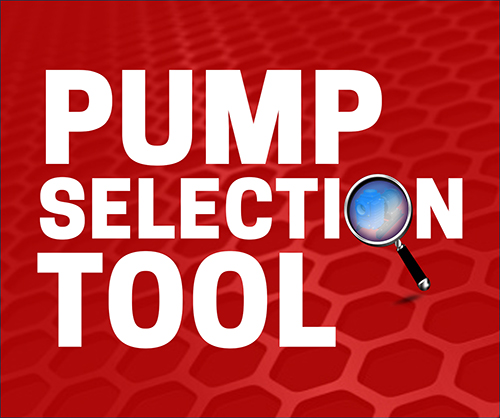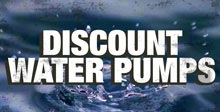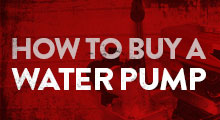Water Pump Cavitation
- By Jackson Carter
- Dec 9, 2019
Pump cavitation is one of the biggest risks to the proper function and lifespan of a water pump. Cavitation is an issue that plagues many of our industrial water pump customers, and can cause very serious damage to the water pump's impeller while slowing down the overall pump flow and effectiveness. How do you avoid cavitation? First, let’s explore exactly what cavitation is, what types of cavitation exist, and then how to prevent or fix this issue.
What is Water Pump Cavitation?
Cavitation is the process in which rapid changes in pressure in a liquid lead to small, vapor filled cavities where the pressure is low. These cavities, or bubbles, can collapse when put into high pressure water and cause a shock wave that can damage the impeller. In simpler terms: the changes in pressure cause bubbles, and when the bubbles increase in pressure they burst and cause shockwaves inside the pump. These shockwaves wear down the impeller and the pump body (volute) over time and can cause some very serious damage which may seem surprising given the size and strength of the bubbles. How is it that bubbles bursting can wear down a metal impeller? The reason cavitation can be so damaging is that it affects the pump over a long period of time. The cavitation may not immediately affect the pump, but over a long period of time, with constant cavitation happening, even a metal impeller can become worn down by bubbles. Before we talk about how to prevent cavitation, we need to talk about the symptoms, the five different types of cavitation, and how they happen.

Symptoms of Pump Cavitation
Before you jump to the assumption that you are dealing with pump cavitation, you need to know the symptoms of it, and make sure that you can properly ensure that any issues you are having are indeed cavitation. The first thing you can easily check for is any unusual noise coming from your pump. When the bubbles burst and cause cavitation, they make a bubbling, almost cracking sound. Another noise to look out for is a rattling coming from the impeller housing, often described by many people as “marbles bouncing around inside the pump.”
This is obviously a sound you don’t want to hear, but it’s an easy way to know that your pump might have a problem like cavitation. The next thing you can check for is if the pump is experiencing any unusual vibrating or shaking. Any cavitation can cause the pump to vibrate and shake, so watch out for your water pump vibrating strangely. You also need to check that your pump has the correct flow and pressure. If either one is decreasing, you could have a cavitation problem inside your pump. The last thing to check without opening the pump up is whether or not your equipment is using more power than usual to move the impeller. If it is cavitation, the bubbles are slowing the impeller down and causing the engine or motor to have to use more power to operate the impeller.
Any more symptoms of pump cavitation require inspection of the pump’s internal parts. Check the impeller and make sure it hasn’t sustained any erosion damage. If it has, or there are small parts of the impeller broken off inside the pump, you almost certainly have a cavitation problem. You should also check your seals and bearings, as cavitation can sometimes cause them to leak or fail.
Vaporization
Vaporization is the most common type of cavitation, and as such is the one that most people are looking to avoid and fix. Often called inadequate NPSHa cavitation or classic cavitation, vaporization happens when the liquid inside the pump passes through the suction side of the impeller which has lower pressure, creating the bubbles. Once the liquid passes through the impeller, any bubbles will cavitate when they encounter the higher pressure, causing the shockwaves. As you already may be able to tell, this can be a very common problem, because it can happen so easily. There are, however, solutions to help prevent vaporization cavitation in your water pump.
This first thing you may want to try is to reduce the RPM (rotations per minute), also known as the motor speed. Slowing down the pump will help reduce the speed at which liquid is flowing, and will also help decrease the head pressure. Just be careful not to reduce the power of your motor too much, as doing so can prevent your pump from pumping at the rate you need it to. Another way to help prevent vaporization cavitation is to purchase an impeller inducer (if your pump is capable of utilizing an inducer). An impeller inducer is basically a smaller impeller that you attach to the front of the main impeller. It is mainly used to increase the pump suction head, or pressure, as well as to help avoid cavitation, as the bubbles that are formed don’t have the main impeller front to attach to. The only problem with this solution is that you would have to buy an impeller inducer, as opposed to changing something in your pump. There are however other ways to try and reduce or prevent vaporization cavitation from happening, such as trying to reduce the temperature of your water pump, as hotter temperatures can also cause vaporization cavitation, as the heat literally vaporizes the water into bubbles. You could also try increasing the liquid level around the suction area of your pump to try and prevent cavitation. It's also possible to increase the diameter of the eye of your impeller, meaning that you will have less surface area for cavitation to occur on the suction side of your impeller. Only do this if it will not affect the amount of liquid you need pumped and has been approved by the manufacturer.
Internal Circulation
Another type of cavitation that can happen inside your pump is called internal circulation. This type of cavitation is a little simpler than vaporization, and can be easier to fix and avoid, as long as you have good pump maintenance. Internal circulation cavitation occurs when the pump discharge port isn’t getting liquid out at the right rate, so any liquid that wasn’t discharged as a result is recirculated back through the water pump. This recirculated liquid goes back through the high- and low-pressure points, causing it to have high heat and velocity, creating the cavitation bubbles that can damage your impeller. A common cause for your pump not discharging enough liquid or discharging it too slowly is that the discharge port was left open while the pump was still running. This is something you should always avoid, as leaving the discharge port closed can cause more problems than just cavitation, which is already something you want to avoid at all costs. In order to fix or avoid internal circulation cavitation, you need to be especially watchful of your discharge port, not allowing it to close while you are running your pump and completing regular maintenance to ensure everything is moving and working well. To make sure your discharge port is functioning, open the pump’s restricted discharge valve and look for any blockage that could be causing the liquid to recirculate. If there is any blockage, remove it and make sure the discharge port is clean and open so that your pump can effectively operate.
You should also make sure that the discharge line has the appropriate pressure. If the pressure is too little or too much you may have a problem with your header. If this is the case, you may need to replace the header to make sure you have the right amount of pressure. Also make sure that the check valve is installed correctly, as a common issue when installing the check valve is that it has been installed backwards. This is as easy as removing the check valve and re-installing it correctly. Any issue with internal circulation is usually related to the discharge line, so always make sure that you are on top of its maintenance and care so that you can avoid damage to your pump and save yourself time.
Vane Passing Syndrome
Vane passing syndrome is another kind a cavitation, and one that can easily be avoided if you do the right research before buying your water pump, but may require some work to fix cavitation that is already occurring. Vane passing syndrome cavitation happens when either the impeller’s diameter is too large, or the pump housing has too thick of a coating. The cavitation happens because there isn’t enough room in the pump body for liquid to pass through, and the smaller amount of space for the water/liquid causes it to gain velocity and decrease the pressure. The decrease in pressure leads to an increase in temperature, and as you know, the increase in temperature leads to bubbles/cavitation.
As mentioned before, vane passing syndrome is very easy to avoid if you planned out your water pump before buying it. Before you buy the pump, make sure that the free space between the impeller and the housing is 4% of the impeller’s diameter or more. If you already have the pump and the impeller or housing is closer than the 4%, you may need to trim down the impeller or contact a mechanic to fix the issue, because as soon as the impeller or housing is less than 4%, cavitation will occur.
Air Aspiration Cavitation
One of the last types of cavitation is air aspiration. You may hear the word air and wonder: what does air have to do with a water pump? You would be surprised at what exactly air aspiration means. Air aspiration cavitation happens when air gets inside the pump because of a failing valve or a weak point like a joint ring. Due to the malfunction, once air is inside, it has no option but to be pumped. Because it’s air and not water or liquid, the air creates bubbles inside the water when moved around in the pump. These bubbles then burst when the impeller spins, and causes damage to your impeller.
The solutions for air aspiration cavitation can be a little trickier than some other cavitation types. Even if only a tiny amount of air gets inside the pump, it can cause cavitation over a long period of time. You should always regularly check the joints, valves, pump body, and pipes of the pump to make sure it doesn’t have any cracks or anything that may allow any air to get inside the water pump. If you do find a crack or other damage, replace the part immediately. Replace any joint rings that have worn down, and make sure all O-rings and mechanical seals are in good shape. Also make sure that the pump you are using is up to the task of pumping the liquid you need it to. Any viscous or acidic liquid could wear down the pump and allow air to leak inside if your pump is not capable of handling said liquid. In general, perform good maintenance on your water pump, and you can avoid air aspiration cavitation.
Turbulence Cavitation
The final type of cavitation seems pretty self-explanatory, as the turbulence caused by the pumping water creates bubbles and causes cavitation. But the pump is always moving water around, so how can you possibly avoid or fix turbulence? The mere moving and pumping of a liquid is not enough to cause turbulence – it takes pipes, filters, valves, and other pump parts that are inadequate for pumping whatever liquid you need pumped that can cause the turbulence. If the parts are not suited, the liquid becomes turbulent and starts experiencing different pressures, leading to cavitation.
Similar to vane passing syndrome cavitation, you can avoid most causes of turbulence cavitation through correct, careful planning on what parts you need, and how much liquid you are pumping, as well as how fast you are pumping it. The different parts of your water pump should be able to handle the strain you’ll be putting on them, and if they are the correct parts, you should be able to avoid turbulence. You should also make sure that you’re not exceeding your water pumps manufacturer’s performance guide. If you push your pump too hard, you may start experiencing turbulence, among other performance issues.
Avoiding cavitation in your water pump is incredibly important, as avoiding it can save you time and money, while prolonging the life of your impeller and pump. Always be aware of any symptoms of cavitation and perform regular checkups and maintenance on your pump so that you can stay on top of any issues that may come. If you do find that you are suffering cavitation, don’t be afraid to ask questions and contact our Application Specialists so that they can help you resolve any problems you might be having and confirm that you have the correct pump for your application.

images courtesy of AMT Pumps







